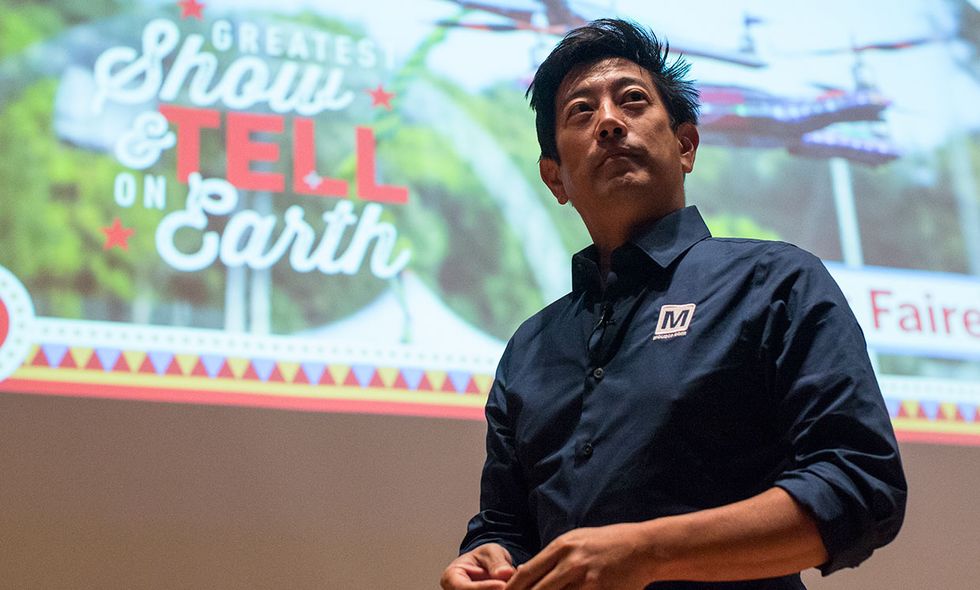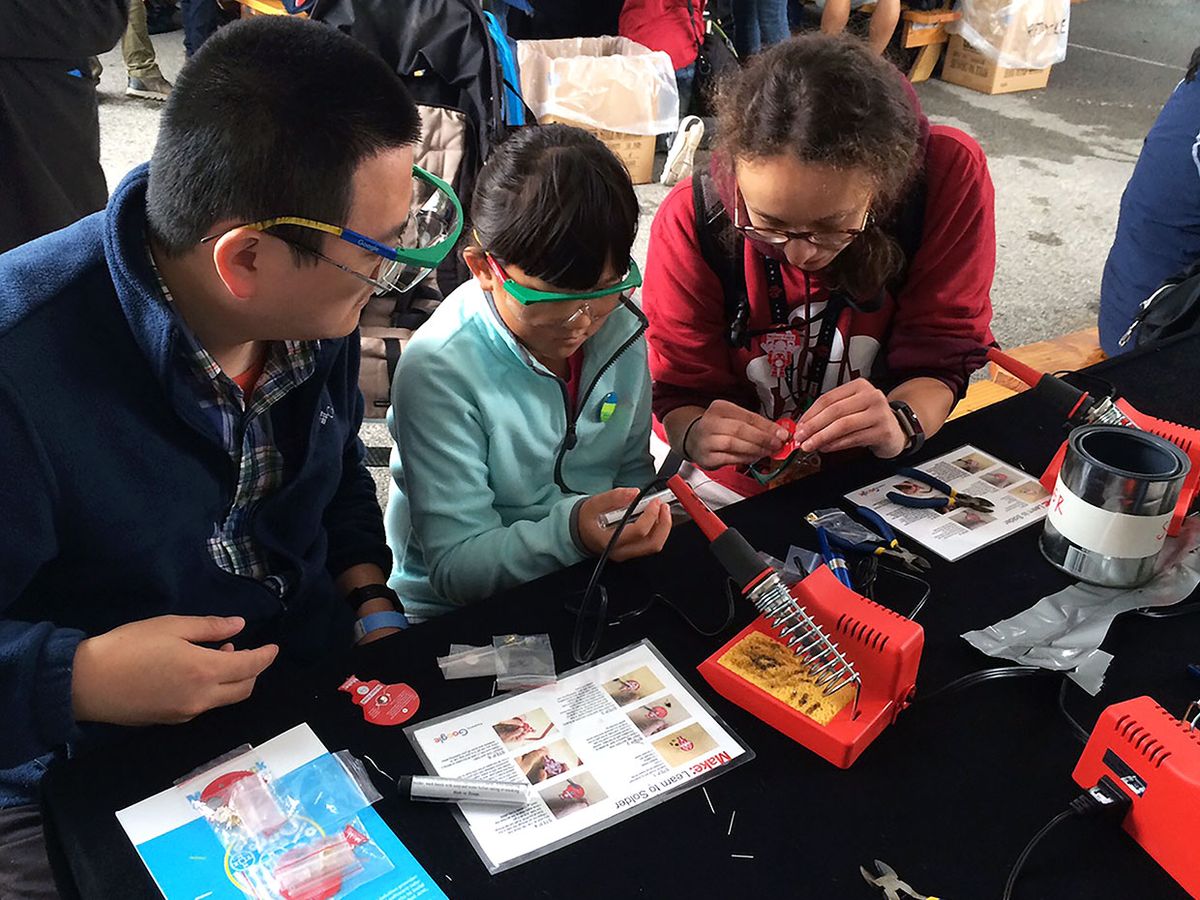THE INSTITUTEElectronic components are now more affordable than ever—expanding possibilities for do-it-yourself projects and perhaps providing the impetus behind a new generation of tinkerers around the globe. Not all new DIYers who are dreaming up ideas for novel devices and bringing them to life have technical backgrounds. In fact, some are not yet in high school.
They can be found working away at so-called makerspaces, typically located in libraries, schools, and community centers. The facilities provide tinkerers with 3D printers, laser cutters, soldering irons, and other tools. Prototypes and finished projects are often displayed at maker events and science competitions.
Last year more than 1.4 million people participated in or visited Maker Faires around the world—double the number from 2014, according to Maker Media, which has been organizing the fairs for 11 years. More than 190 events were held last year in 38 countries. Companies and other organizations sponsor booths. IEEE has sponsored booths as well in recent years, and is part of the maker movement.
The grassroots movement encourages tinkerers to design, build, and demonstrate their projects while learning from one another. People with varying degrees of technical expertise are involved, from novices to engineers.
“The movement is about our desire to understand the world around us and manipulate things to make new products or use existing ones in new ways,” says IEEE Senior Member Tom Coughlin, past director of IEEE Region 6 and chair of the IEEE public visibility committee, which aims to increase people’s awareness of IEEE and its members. He and several IEEE volunteers led activities at the organization’s booth during the Maker Faire Bay Area event, held this year from 19 to 21 May in San Mateo, Calif.
“The maker movement is essentially a modern term to describe something that has been around ever since humans started using stones as tools,” Coughlin says.

The movement is more than just a few fairs each year. It is a way to inspire the next generation of technologists year-round, Coughlin says. For example, the IEEE Maker Project inspires tinkerers to come up with inventions in areas that include health care, entertainment, and transportation. IEEE Educational Activities awards a US $500 grant to an IEEE group in each region that holds a maker event. And IEEE has developed an informal partnership with Maker Media to support one another’s efforts in maker activities.
ENDLESS POSSIBILITIES
At Maker Faire events last year, booths organized by high-tech companies, schools, and other organizations offered activities that taught visitors how to solder and use a 3D printer. They also covered how to incorporate chips, sensors, and other electronics into their projects, as well as how to code. IEEE members were there to help.
One was Life Senior Member Charles Rubenstein. He has organized the IEEE booth for the past six years at the annual World Maker Faire, scheduled this year for 23 and 24 September in New York City. He notes that the movement goes above and beyond a traditional science fair, because students don’t merely research a project and make a poster about it; they actually build a model of their idea.
“They can build an autonomous drone, for example, with GPS and a webcam to track where it flies and where it will land and program it to send the information back to their laptops,” Rubenstein says.
He hopes to get more members involved, especially from IEEE Women in Engineering and IEEE Young Professionals. Such volunteers can serve as role models to the tens of thousands of students who attend.
During one World Maker Faire, members of the IEEE student branch at Rutgers University in New Brunswick, N.J., showed off their DIY robot at the IEEE booth. The students asked visitors to draw a meandering line on a big piece of paper. A hand-size wheeled robot then followed the line, as light-detecting sensors distinguished the contrast between the drawn line and the paper’s lighter background. It was one way to engage kids who came by the booth, and teach them about robotics, Rubenstein notes.
Another hands-on project at last year’s event, sponsored by the Institute of Engineering and Technology, taught visitors to build an LED flashlight. Kits included two batteries and light-emitting diodes, and were designed so that participants—including a few 5-year-olds—didn’t need to solder anything to put them together.
For Rubenstein, who teaches an introductory electronics course for non-engineering majors at Pratt Institute, in New York City, the beauty of maker events is that participants don’t have to know why a technology works. If they just know how to assemble the components, they can design and build their own projects.
HOME-GROWN FAIRS
In a few parts of the world where Maker Media has not held maker fairs, IEEE volunteers have organized their own. For example, more than 800 people attended the two-day IEEE Digital Maker Expo in May in Miri, Malaysia, hosted by the IEEE student branch at Curtin University.
This month IEEE volunteers in India are holding their second annual Project Competition and Maker Fair at the Vardhaman College of Engineering, in Hyderabad. More than 350 people are expected to attend, according to IEEE Senior Member Ramalatha Marimuthu, chair of the event.
A number of the devices shown last year tried to improve the quality of life for those with disabilities, Marimuthu says. Projects included eyeglasses that rely on facial-recognition software to help the visually impaired identify people they know, as well as an “intelligent” walking stick to assist users with their balance. Several of the makers from last year’s event are working to bring their projects to market, Marimuthu adds.
Such projects are the reasons why Coughlin says he became part of the maker movement. “I believe the ingenuity of individual makers will help solve some of the world’s biggest problems,” he says. “And that’s why IEEE must be part of this movement.”
